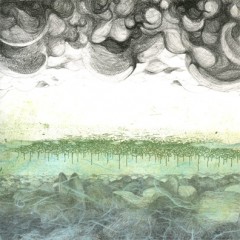Essays Jane Wong — March 27, 2014 14:21 — 2 Comments
Beauty Was the Case That They Gave Me – Jane Wong
What I discovered: there is no such thing as too much beauty, too much poetry, or too much limoncello! I ended my Wednesday night of APRIL’s festival (Authors, Publishers, and Readers of Independent Literature) eating chicken rice at Kedai Makan. But really, I wish I ate “pieces of toast dipped in toilet water†because that’s what one Mark Leidner poem deliciously suggests.Â
APRIL’s third day of the festival began with a happy hour reading at Blindfold, a gallery tucked along the slope of John turning into Olive. Poets Shin Yu Pai and Zubair Ahmed read alongside Justin Duffus’s paintings. Woozy with red wine and PNW mist, we all crowded in to listen as Pai read. Engaged with art objects, her work is palatable, darkly lyrical, and deeply embodied: “melting in your mouth feel.†This focus on the transformative was echoed in Ahmed’s work, which looks out into the world with fresh eyes: “the landscape looks like a rotting nail.†Before reading his heartbreaking new work, Ahmed exuberantly declares: “I love the irrational!â€
To celebrate the irrational, I wandered down the hill toward Vignettes with Tara Atkinson, a co-founder of APRIL. I wasn’t sure if I’d been to Vignettes before, but then suddenly I had the memory of hamburgers and eating them in the welcoming arms of the El Capitan apartment building.
We went up the elevator (how much of our lives have been spent in an elevator, looking up?) and walked into Vignettes for the evening’s group exhibition, inspired by Leidner’s book Beauty Was the Case That They Gave Me. Quickly, the show became packed and sweaty. Everyone glowed a bit – from the art objects, from the limoncellos made by Letterpress Distilling, from the confluence of poets and artists.
Curated by Aidan Fitzgerald and Sierra Stinson, the show featured work from Kimberly Trowbridge, MKNZ, Max and Graham, Nate Steigenga, Nick Bartoletti and Claire Haranda, Rafael Soldi, and Todd Jannausch. Echoing Leidner’s poems, the pieces were bright, intimate, and full of the potential to bruise.
One of my favorite pieces was by Kimberly Trowbridge, which offered a theatre of objects. When I asked her about what it was like responding to Leidner’s work, she spoke of honoring the long poem: “My instinct was to choose an image from a particular stanza, but his poems are these long, rambling epics so the sense of time built into them was so important to me. I set up this huge challenge to respond to a poem in its entirety. I started making all these objects, like a theatre, in which I could interact with them.†This interaction with objects, she told me, also spills over into artistic interaction: “In a studio, I’m usually alone. I’m in a different phase in my life in which I want to respond to other people’s ideas. I feel more open to being out in the world.â€
Graham Downing and Max Kraushaar’s video installation in the closet was also a standout. The piece felt meditative, quietly tucked away from the brightness of the living room. The 30-minute loop responded to Leidner’s line: “Breathing skeptically in the humid air of a new planet.” One viewer kept reaching out to the video screen, saying: “I want to get closer.â€
Held in a small apartment, I felt comfortable interacting with these artists’ intimate responses. There were installations in the closet, in the bedroom, in the living room. Unlike a gallery or museum, Vignettes welcomes a happenstance community of people into its home. As Aidan Fitzgerald, the exhibit’s co-curator said to me: “You’re in a close space. Maybe you know someone, maybe you don’t. It’s welcoming. Poetry is similarly intimate. Vignettes is perfect for that.â€
I also talked to Fitzgerald about the process of co-curating this event and collaborations between writers and artists: “For artists like Rafael, he makes deeply intense, personal work. There’s something going on there, like a dark vibration that could only come from a story… It’s also great to see that they picked some of my favorite pieces from the collection, like “The River,†which is such a heartbreaking poem. There’s such fucked up sadness in there.†The act of collaboration also pushes expectations: “One of the greatest pleasures of this show is that two of the artists made the complete opposite work that we thought they would. Nick works with video art and he ended up making a sculpture with Claire. And Kimberly is a painter and she made a video and an installation.â€
After viewing the exhibition, we all packed in, gleaming foreheads and all, to listen to Leidner read with hilarious ferocity. He warned us about the length of his poems, but that just made me settle in more. His ability to build narrative through litany was particularly impressive – zooming in and out of humor, heartbreak, and horror. We move from lines like “the fangs and eyes of your face like gossip†to “fireflies, feces, snow†to “it’s like needing someone but not knowing it.†When Leidner reads “It’s her second day at Ruby Tuesdays and he’s worked there for five years,†everyone laughs and hurts like we’ve been running for miles.
2 Comments
Leave a Reply
The answer isn't poetry, but rather language
- Richard Kenney




I believe it’s spelled Kraushaar.
Fixed! Our apologies!